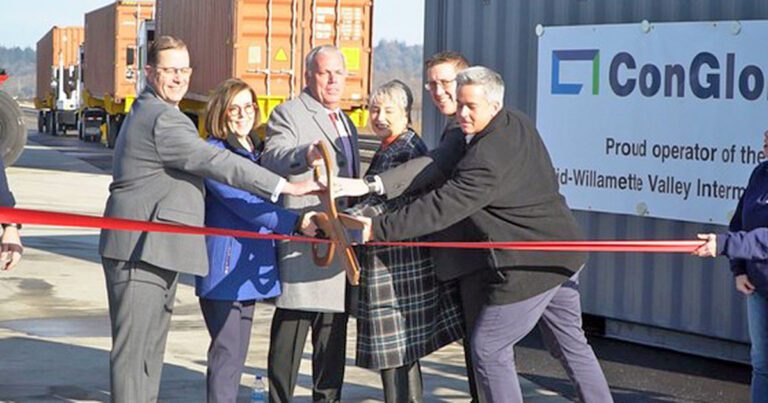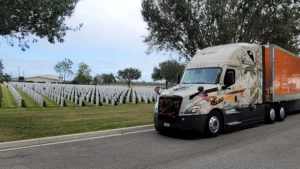MILLERSBURG, Ore. – Ribbon-cutters gathered between two shipping containers to mark the grand opening and completion of the Mid-Willamette Valley Intermodal Center on Dec. 16 in Millersburg, Oregon, a small community in the heart of western Oregon’s agricultural country.
Almost 200 supporters attended the celebration for the project, which will serve as an intermodal center for the valley’s natural resource-based economy.
Trucks will bring cargo in international containers to the facility so it can be transferred to rail cars, which then head north to marine terminals in Seattle and Tacoma – bypassing busy Interstate 5 congestion along the way.
“In 2017, we chose four projects to receive ODOT’s (Oregon Department of Transportation) Connect Oregon funding, based on the multiple benefits these projects would bring us. I’m proud to say we made a great choice – the right choice,” Oregon Gov. Kate Brown said. “Working together, we have created a success we can all be proud of.”
Several guest speakers shared their perspectives, including Roger Nyquist, Linn County commissioner and Board vice chair for the Linn County Economic Development Group, which led the way in getting support for the project.
“Our region has a long history of producing products that are beneficial to people around the world — from two-by-fours to the food people put on their dinner plates,” Nyquist said. “This intermodal facility ensures the products will have ample transportation access to those markets long into the future.”
ODOT Director Kris Strickler said the agency has never before developed a major freight intermodal transfer hub.
“Connect Oregon has never taken a site used for something else and turned it into a non-highway-funded transportation facility,” Strickler said. “I’m particularly proud of this project because of what it demonstrates: that the public and private sectors can do great things when we work together for good.”
Aaron Hunt, senior director of public affairs for Union Pacific, said that the railroad is looking forward to serving Mid-Willamette Valley Intermodal customers.
“Moving Mid-Willamette valley products by rail will reduce greenhouse gas emissions and prevent further congestion on Oregon and Washington highways,” Hunt added.
Hunt said freight railroads account for roughly 40% of U.S. long-distance freight volume (measured by ton-miles) — more than any other mode of transportation. Yet they account for just 0.5% of total U.S. greenhouse gas emissions, according to EPA data, and just 1.9% of transportation-related greenhouse gas emissions.
Potential shippers using the facility include Karla Chambers and her family’s company, Stahlbush Island Farms, Inc.
Chambers spoke at the ribbon-cutting and emphasized how important the facility is going to be.
“The vision for this project was to make exporters and importers more cost- and equipment-efficient; to get trucks and freight out of Portland traffic; and to be more competitive moving freight to the Midwest and East Coast U.S. buyers,” Chambers said. “This rail facility will also help us as we experience high diesel costs and truck driver and labor shortages.”
ODOT’s Connect Oregon program provides funding for non-highway projects that bring multiple benefits to an area.
The $35.5 million, 64-acre Mid-Willamette Valley Intermodal Center will reduce greenhouse gas emissions by taking trucks off the roadways and using rail instead. It will give farmers and others another option for getting goods to market and may reduce shipping costs, while also giving the local economy a boost with potential for new businesses and services.
The Trucker News Staff produces engaging content for not only TheTrucker.com, but also The Trucker Newspaper, which has been serving the trucking industry for more than 30 years. With a focus on drivers, the Trucker News Staff aims to provide relevant, objective content pertaining to the trucking segment of the transportation industry. The Trucker News Staff is based in Little Rock, Arkansas.















